
Canals or artificial waterways are waterways or engineered channels built for drainage management or for conveyancing water transport vehicles. They carry free, calm surface flow under atmospheric pressure, and can be thought of as artificial rivers.

The Saône is a river in Eastern France. It is a right tributary of the Rhône, rising at Vioménil in the Vosges department and joining the Rhône in Lyon, at the southern end of the Presqu'île.

The Canal du Midi is a 240 km (150 mi) long canal in Southern France. Originally named the Canal Royal en Languedoc and renamed by French revolutionaries to Canal du Midi in 1789, the canal is considered one of the greatest construction works of the 17th century.

Regent's Canal is a canal across an area just north of central London, England. It provides a link from the Paddington Arm of the Grand Union Canal, 550 yards (500 m) north-west of Paddington Basin in the west, to the Limehouse Basin and the River Thames in east London. The canal is 8.6 miles (13.8 km) long.

The Scarpe is a river in the Hauts-de-France region of France. It is a left-bank tributary of the river Escaut (Scheldt). It is 94 km (58 mi) long. The source of the river is at Berles-Monchel near Aubigny-en-Artois. It flows through the towns of Arras, Douai and Saint-Amand-les-Eaux. The river ends at Mortagne-du-Nord where it flows into the Scheldt. Scarpe Mountain in Alberta, Canada, was named after the river. The navigable waterway and its coal barges also feature in the novels by 19th century author Émile Zola.
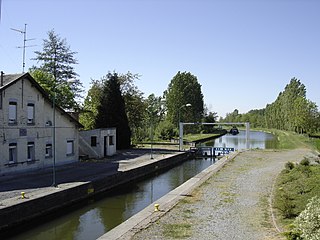
The Canal de la Sambre à l'Oise is a canal in northern France. It forms a connection between the canalised river Sambre at Landrecies and the Oise at La Fère. The canal is 71 kilometres (44 mi) long, and has 38 locks. The junction made at La Fère is with a branch of the Canal de Saint-Quentin, while the Canal latéral à l'Oise is joined 10.5 km further downstream at Chauny. It was used by the standard Freycinet-gauge péniches, 38.50 metres (126.3 ft) long, and 5.05 metres (16.6 ft) in beam, carrying up to 250 tonnes. The canal, also a popular waterway for boats heading south from the Netherlands and Belgium to the central French waterways, had to be closed in 2006 when two aqueducts were found to be in danger of failing. Funding has been put in place by the owner, Voies Navigables de France, and the local authorities, with support from the State. The canal was reopened in July 2021.

The Canal de Bourgogne is a canal in the Burgundy historical region in east-central France. It connects the Yonne at Migennes with the Saône at Saint-Jean-de-Losne. Construction began in 1775 and was completed in 1832. The canal completes the link between the English Channel and the Mediterranean Sea, via the rivers Seine and the Yonne to the Saône and Rhône.

The Canal de la Marne au Rhin is a canal in north-eastern France. It connects the river Marne and the Canal entre Champagne et Bourgogne in Vitry-le-François with the port of Strasbourg on the Rhine. The original objective of the canal was to connect Paris and the north of France with Alsace and Lorraine, the Rhine, and Germany. The 313 km (194 mi) long canal was the longest in France when it opened in 1853.

The Canal de Garonne, formerly known as Canal latéral à la Garonne, is a French canal dating from the mid-19th century that connects Toulouse to Castets-en-Dorthe. The remainder of the route to Bordeaux uses the river Garonne. It is the continuation of the Canal du Midi which connects the Mediterranean with Toulouse.
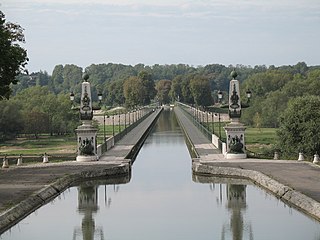
The Briare Aqueduct in central France carries the Canal latéral à la Loire over the river Loire on its journey to the Seine. It replaced a river-level crossing from the canal to meet the Briare Canal that was hazardous in times of flood. Between 1896 and 2003 it was the longest navigable aqueduct in the world, until the opening of the Magdeburg Water Bridge.

The Canal latéral à la Loire was constructed between 1827 and 1838 to connect the Canal de Briare at Briare and the Canal du Centre at Digoin, a distance of 196 kilometres (122 mi). It replaced the use of the river Loire, which was unreliable during winter floods and summer droughts. Aqueducts were used to cross the Allier at Le Guétin and the Loire at Digoin. However, because of the extreme length required, an aqueduct was not built to cross the Loire at Briare until 1896, when the Briare aqueduct was constructed.

The Canal de Berry is a disused canal in France which links the Canal latéral à la Loire at Marseilles-lès-Aubigny with the Cher at Noyers rejoining the Loire near Tours. With a branch from Montluçon it provided 261 kilometres (162 mi) of canal with locks 2.7 metres (8.9 ft) wide from 1840 until its closure in 1955. There is now a 15 kilometres (9.3 mi) operational segment with five locks between Selles-sur-Cher and Noyers-sur-Cher.

The Brussels–Charleroi Canal, also known as the Charleroi Canal amongst other similar names, is an important canal in Belgium. The canal is quite large, with a Class IV Freycinet gauge, and its Walloon portion is 47.9 kilometres (29.8 mi) long. It runs from Charleroi (Wallonia) in the south to Brussels in the north.
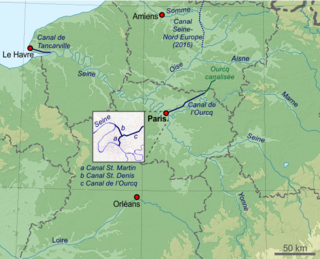
The Canal Saint-Denis is a canal in Paris, France that is 6.6 kilometres (4.1 mi) in length. The canal connects the Canal de l'Ourcq, at a point north-northwest of the Bassin de la Villette in the 19th arrondissement, with the suburban municipalities of Saint-Denis and Aubervilliers in the department of Seine-Saint-Denis. There are seven locks along the canal's route, and, near Saint-Denis, the canal discharges into the Seine.
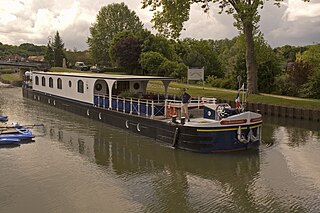
Renaissance was built in Belgium in 1960 as a standard péniche barge to carry cargo along the canals of Europe. Her original cargo was grain and iron ore. She presently serves as a hotel barge, owned and operated by European Waterways. She is one of around 60 barges offering luxury cruises on French waterways.
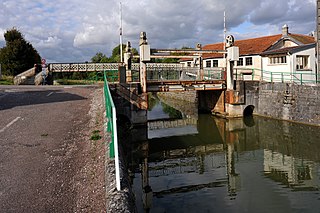
The Canal entre Champagne et Bourgogne, previously named Canal de la Marne à la Saône, is a canal in north-eastern France connecting the towns of Vitry-le-François and Maxilly-sur-Saône. It is a summit level canal of Freycinet dimensions connecting the Marne and the Saône. It is 224.191 kilometres long, and has 114 locks and two tunnels, Condes which is 275 metres long and the tunnel on the summit level between Balesmes-sur-Marne and Noidant-Chatenoy, 4820 metres long. which runs almost exactly underneath the source of the Marne.

The Classification of European Inland Waterways is a set of standards for interoperability of large navigable waterways forming part of the Trans-European Inland Waterway network within Continental Europe and Russia. It was created by the European Conference of Ministers of Transport in 1992, hence the range of dimensions are also referred to as CEMT Class I–VII.

The Givors canal was built between 1761 and 1781 to carry coal, other goods and passengers from Rive-de-Gier to Givors on the Rhône, running beside the river Gier.

A péniche is a steel motorised inland waterway barge of up to 350 tonnes' capacity. Péniche barges were built to fit the post-1880s French waterways and the locks of Freycinet gauge. They are visually similar to a Dutch barge, but built to different specifications.

A widebeam is a canal boat built in the style of a British narrowboat but with a beam of 2.16 metres or greater.




















